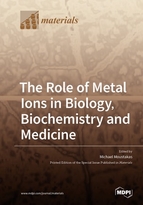The Role of Metal Ions in Biology, Biochemistry and Medicine
A special issue of Materials (ISSN 1996-1944). This special issue belongs to the section "Biomaterials".
Deadline for manuscript submissions: closed (30 September 2020) | Viewed by 47839
Special Issue Editor
Interests: plant ecophysiology; biotic stress; abiotic stress; photosynthesis; antioxidative mechanisms; photoprotective mechanisms; mineral nutrition; ROS
Special Issues, Collections and Topics in MDPI journals
Special Issue Information
Dear Colleagues,
Metal ions are fundamental elements for the maintenance of lifespan of plants, animals and humans. Their substantial role in biological systems was recognized a long time ago. They are essential for the maintenance of life and their absence can cause growth disorders, severe malfunction, carcinogenesis or death. They are protagonists as macro or microelements in several structural and functional roles, participating in many biochemical reactions and arise in several forms. They participate in intra and inter cellular communications, in maintaining electrical charges and osmotic pressure, in photosynthesis and electron transfer processes, in the maintenance of pairing, stacking and the stability of nucleotide bases, in regulation of DNA transcription, proper functioning of nerve cells, muscle cells, brain and heart, transport of oxygen and in many other biological processes up to the point that we cannot even imagine a life without metals. With the application of new modern methods to study biological and biochemical systems, new and sophisticated roles of metal ions in living systems can be revealed in articles in this Special Issue that aims to highlight some of the new advances.
We would like to invite experts in the field to contribute both original research papers, as well as review articles, covering basic aspects and future directions in the field.
Prof. Michael Moustakas
Guest Editor
Manuscript Submission Information
Manuscripts should be submitted online at www.mdpi.com by registering and logging in to this website. Once you are registered, click here to go to the submission form. Manuscripts can be submitted until the deadline. All submissions that pass pre-check are peer-reviewed. Accepted papers will be published continuously in the journal (as soon as accepted) and will be listed together on the special issue website. Research articles, review articles as well as short communications are invited. For planned papers, a title and short abstract (about 100 words) can be sent to the Editorial Office for announcement on this website.
Submitted manuscripts should not have been published previously, nor be under consideration for publication elsewhere (except conference proceedings papers). All manuscripts are thoroughly refereed through a single-blind peer-review process. A guide for authors and other relevant information for submission of manuscripts is available on the Instructions for Authors page. Materials is an international peer-reviewed open access semimonthly journal published by MDPI.
Please visit the Instructions for Authors page before submitting a manuscript. The Article Processing Charge (APC) for publication in this open access journal is 2600 CHF (Swiss Francs). Submitted papers should be well formatted and use good English. Authors may use MDPI's English editing service prior to publication or during author revisions.
Keywords
- Metal Ions
- Metal Deficiency and Toxicity
- Micro-Macronutrients
- Metal Transport
- Metalloenzymes
- Metallothionins
- Metallomics
- Metal Ions and Nucleotides
- Metals in Health and Disease
- Metal Homeostasis
- Metal Hyperaccumulation
- Metal Imaging and Sensing
- Metal Ions and Cancer
- Metallopharmaceuticals
- Metallic Nanoparticles







